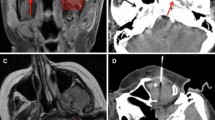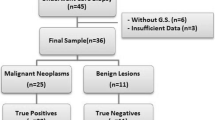Abstract
Summary
Computed tomography (CT)-guided percutaneous biopsy of deep-seated head and neck lesions can be a less invasive and equally effective alternative to surgical techniques. There are multiple approaches for needle biopsy that target varying spaces within the head and neck while successfully avoiding critical anatomy. In the paramaxillary approach, the needle is advanced through the infrazygomatic buccal space, in between the maxilla and mandible. In this study, we examine the safety and diagnostic yield of FNA without core needle biopsy performed via the paramaxillary approach in 19 patients yielding 20 fine needle aspirates between 2014 and 2022. Of the fine needle aspirates, 85.0% (17/20) were diagnostic. Concordant histopathologic diagnosis was obtained in 100% (17/17) diagnostic fine needle aspirates. There were no postprocedural complications.


Similar content being viewed by others
References
Pynnonen MA, Gillespie MB, Roman B et al (2017) Clinical practice guideline: evaluation of the neck mass in adults. Otolaryngol Head Neck Surg 157(2_suppl):S1–S30
Layfield LJ (1996) Fine-needle aspiration of the head and neck. Pathology (Phila) 4(2):409–438
Sherman PM, Yousem DM, Loevner LA (2004) CT-guided aspirations in the head and neck: assessment of the first 216 cases. AJNR Am J Neuroradiol 25:1603–1607
DelGaudio JM, Dillard DG, Albritton FD, Hudgins P, Wallace VC, Lewis MM (2000) Computed tomography–guided needle biopsy of head and neck lesions. Arch Otolaryngol Head Neck Surg 126:366–370
Gupta S, Henningsen JA, Wallace MJ et al (2007) Percutaneous biopsy of head and neck lesions with CT guidance: various approaches and relevant anatomic and technical considerations. Radiographics 27(2):371–390
Abemayor E, Ljung BM, Ward PH, Larsson S, Hanafee W (1985) CT-directed fine needle aspiration biopsies of masses in the head and neck. Laryngoscope 95:1382–1386
McKnight CD, Glastonbury CM, Ibrahim M, Rivas-Rodriguez F, Srinivasan A (2017) Techniques and approaches for safe, high-yield CT-guided suprahyoid head and neck biopsies. AJR Am J Roentgenol 208(1):76–83
Sack MJ, Weber RS, Weinstein GS, Chalian AA, Nisenbaum HL, Yousem DM (1998) Image-guided fine-needle aspiration of the head and neck: five years’ experience. Arch Otolaryngol Head Neck Surg 124(10):1155–1161
Brennan PA, Mackenzie N, Oeppen RS, Kulamarva G, Thomas GJ, Spedding AV (2007) Prospective randomized clinical trial of the effect of needle size on pain, sample adequacy and accuracy in head and neck fine-needle aspiration cytology. Head Neck 29(10):919–922. https://doi.org/10.1002/hed
Funding
This study received no funding.
Author information
Authors and Affiliations
Corresponding author
Ethics declarations
Ethics approval
This study was approved by the Institutional Review Board (IRB) at Weill Cornell Medicine (protocol 9–08020630).
Informed consent
Informed consent was obtained from all individual participants within the study.
Conflict of interest
The authors have no other funding, financial relationships, or conflict of interests to disclose.
Additional information
Publisher's note
Springer Nature remains neutral with regard to jurisdictional claims in published maps and institutional affiliations.
Rights and permissions
Springer Nature or its licensor holds exclusive rights to this article under a publishing agreement with the author(s) or other rightsholder(s); author self-archiving of the accepted manuscript version of this article is solely governed by the terms of such publishing agreement and applicable law.
About this article
Cite this article
Wang, D., Chazen, J.L., Kutler, D.I. et al. Paramaxillary CT-guided fine needle aspiration of head and neck lesions: technique, diagnostic yield, and safety profile. Neuroradiology 64, 2207–2211 (2022). https://doi.org/10.1007/s00234-022-03037-1
Received:
Accepted:
Published:
Issue Date:
DOI: https://doi.org/10.1007/s00234-022-03037-1




